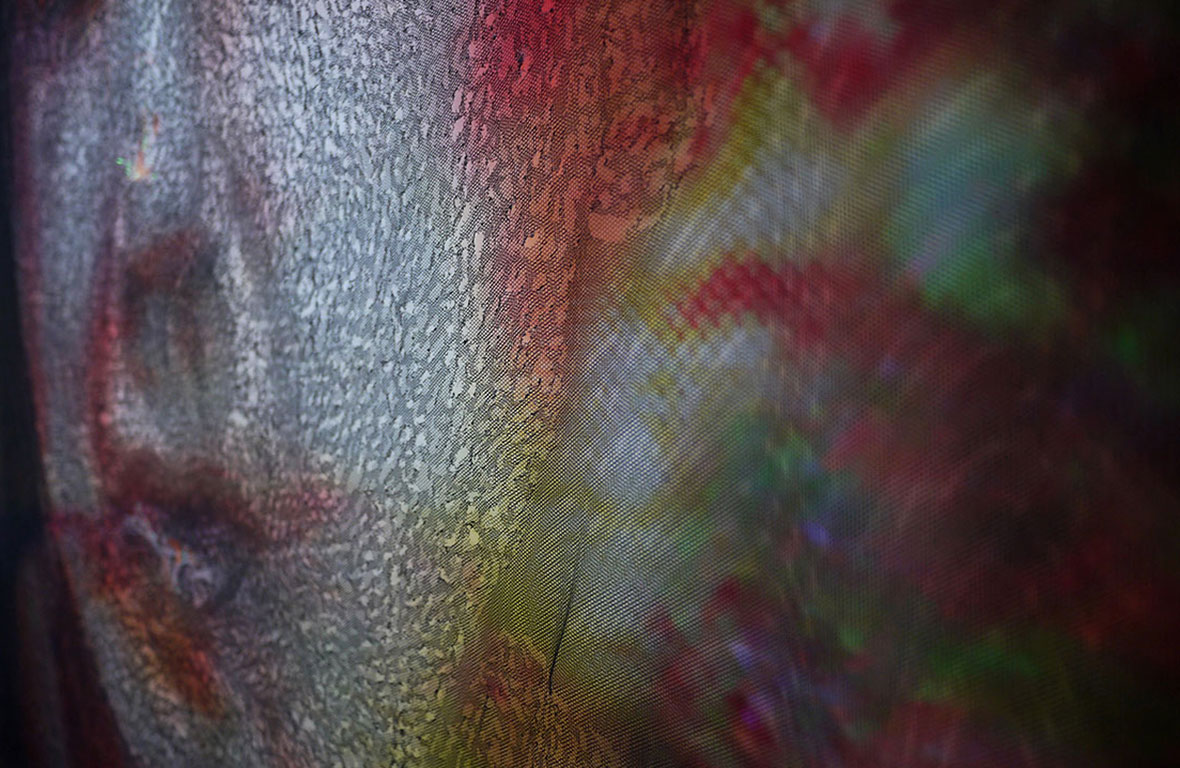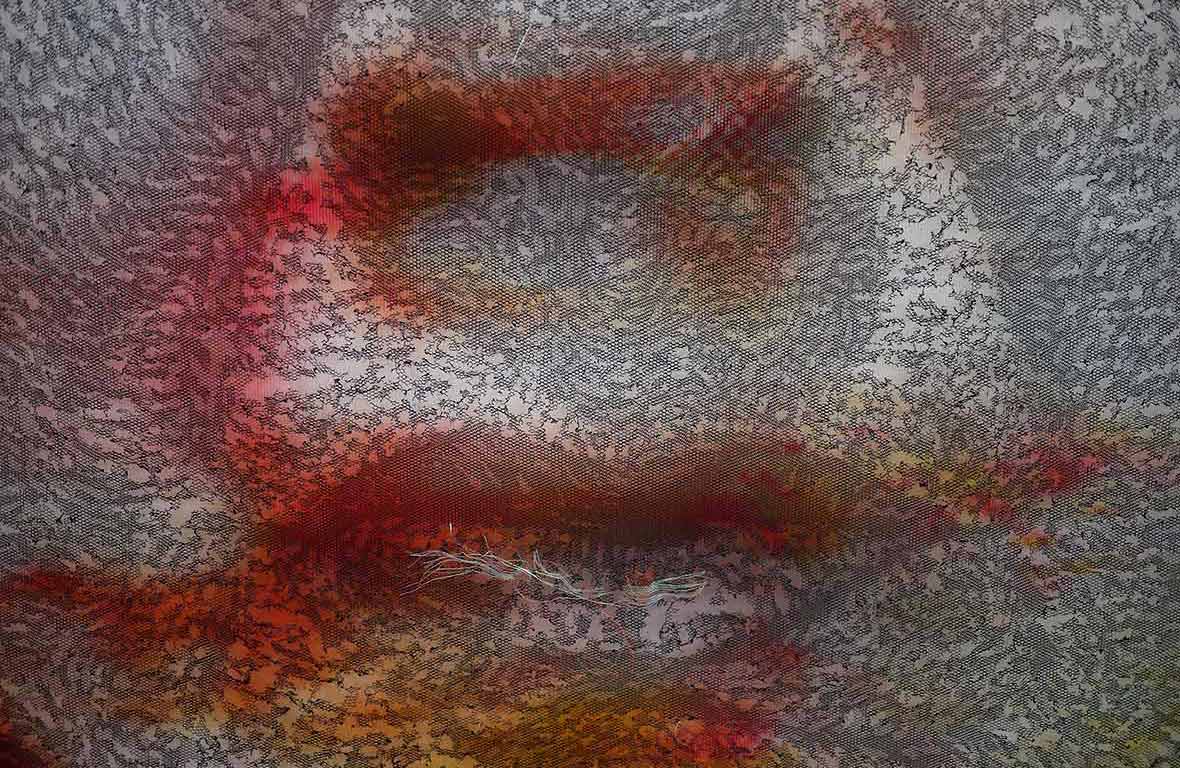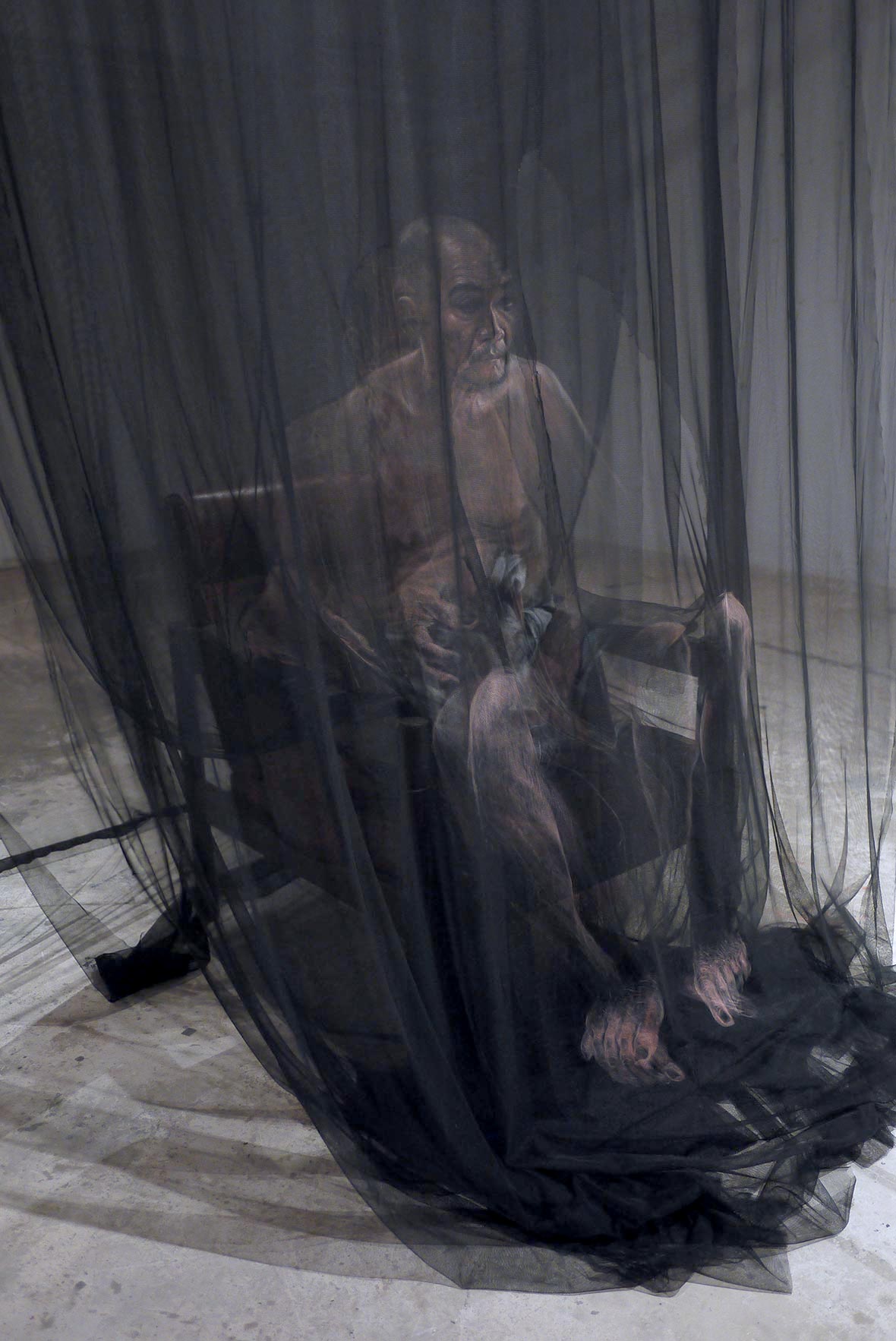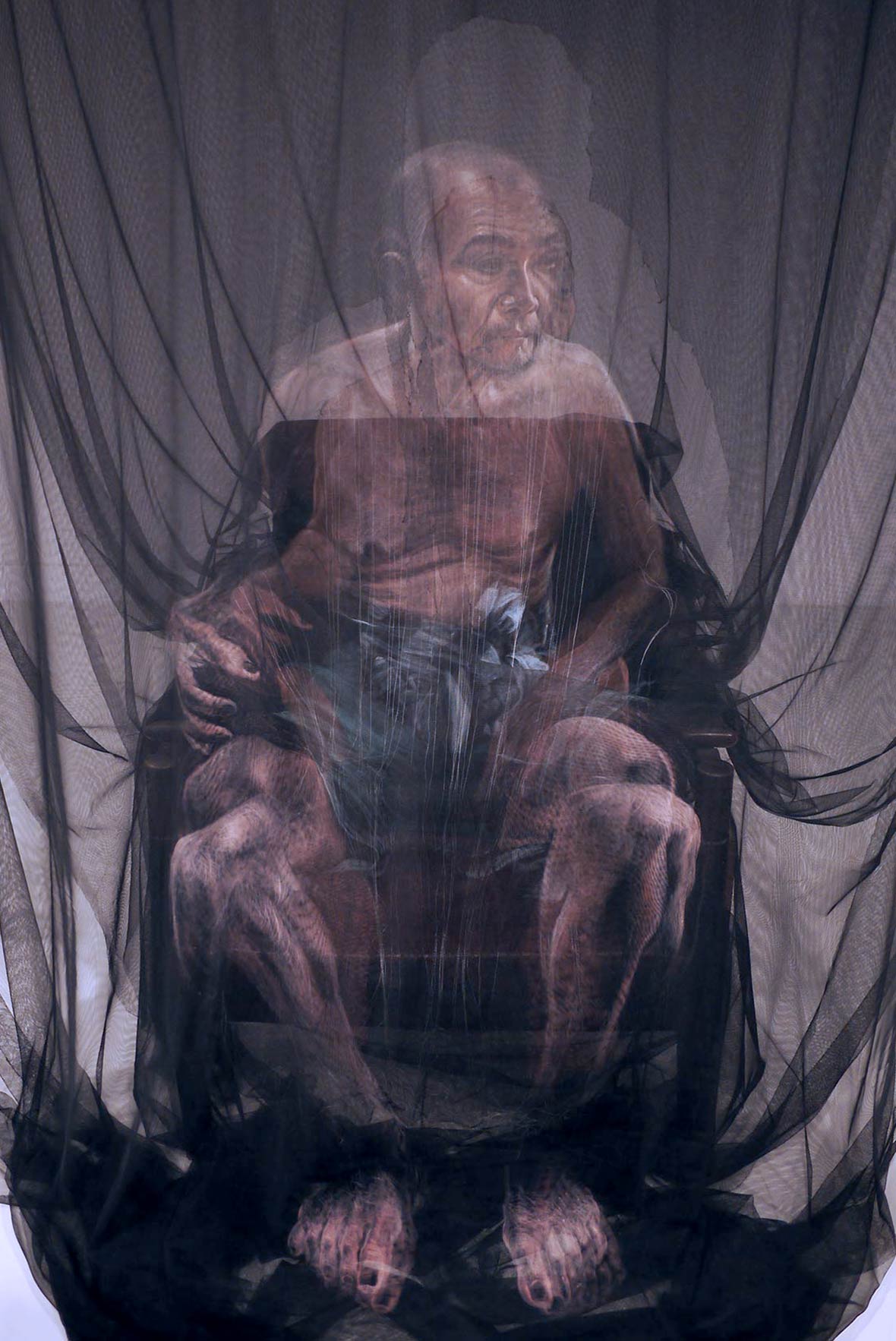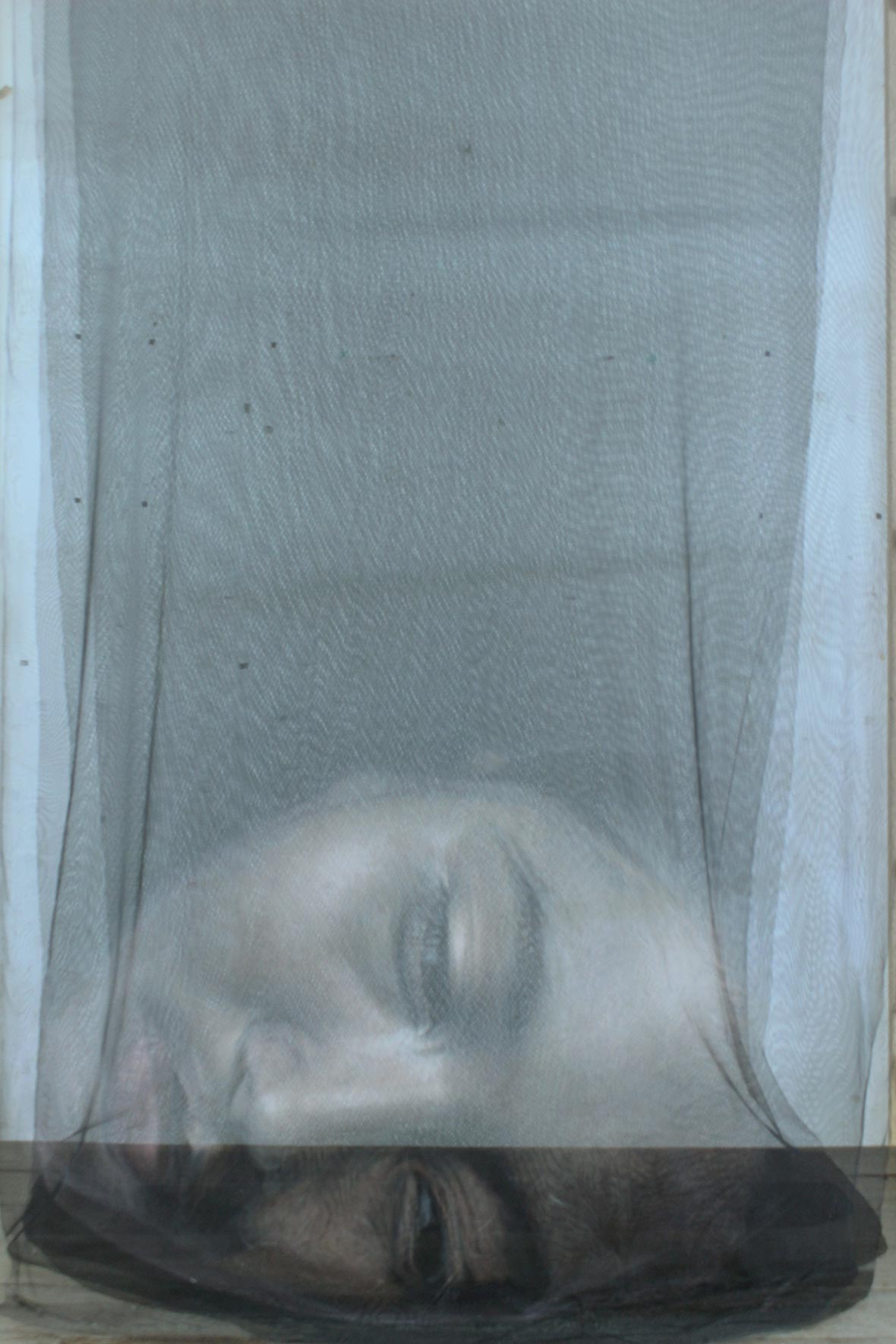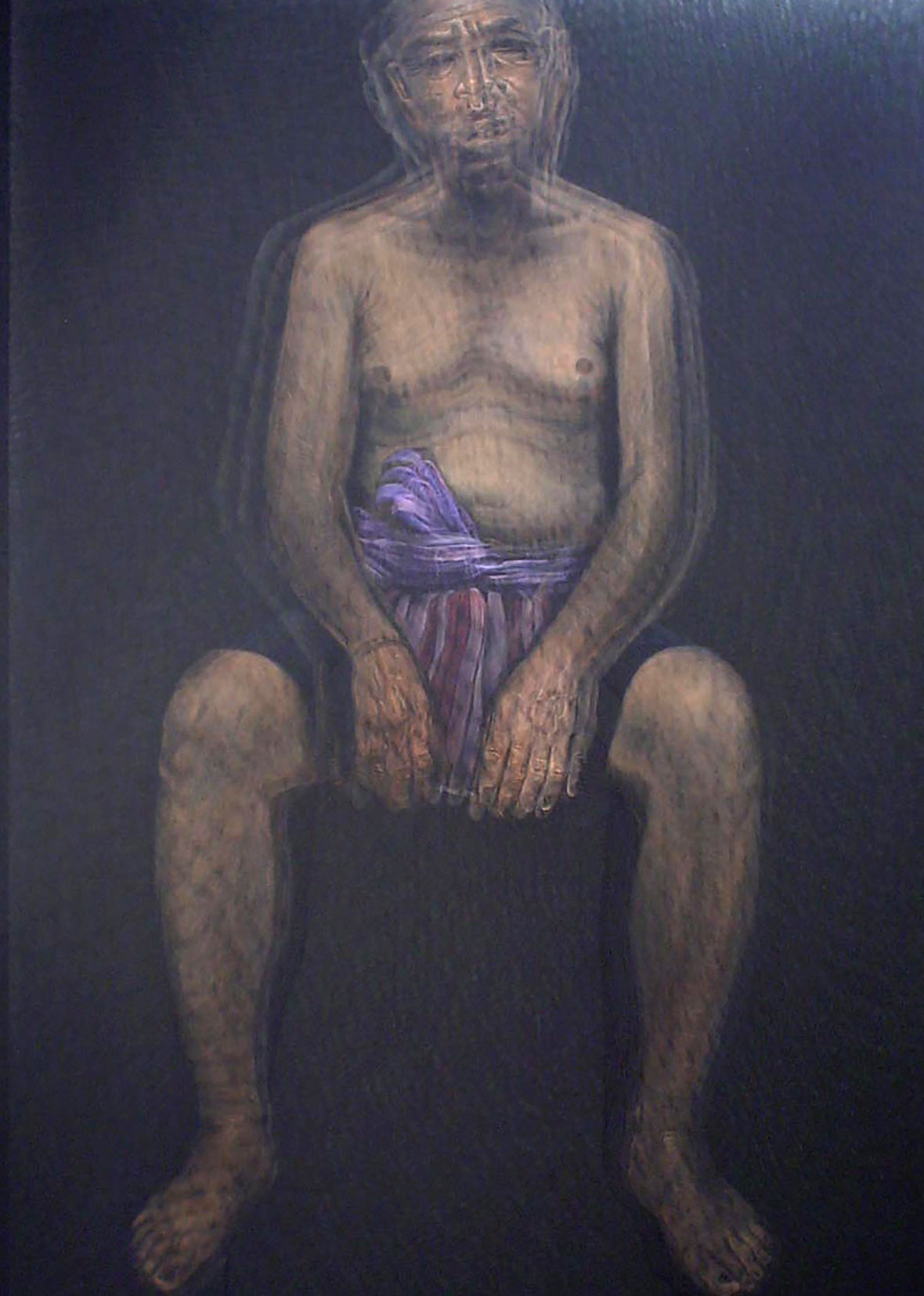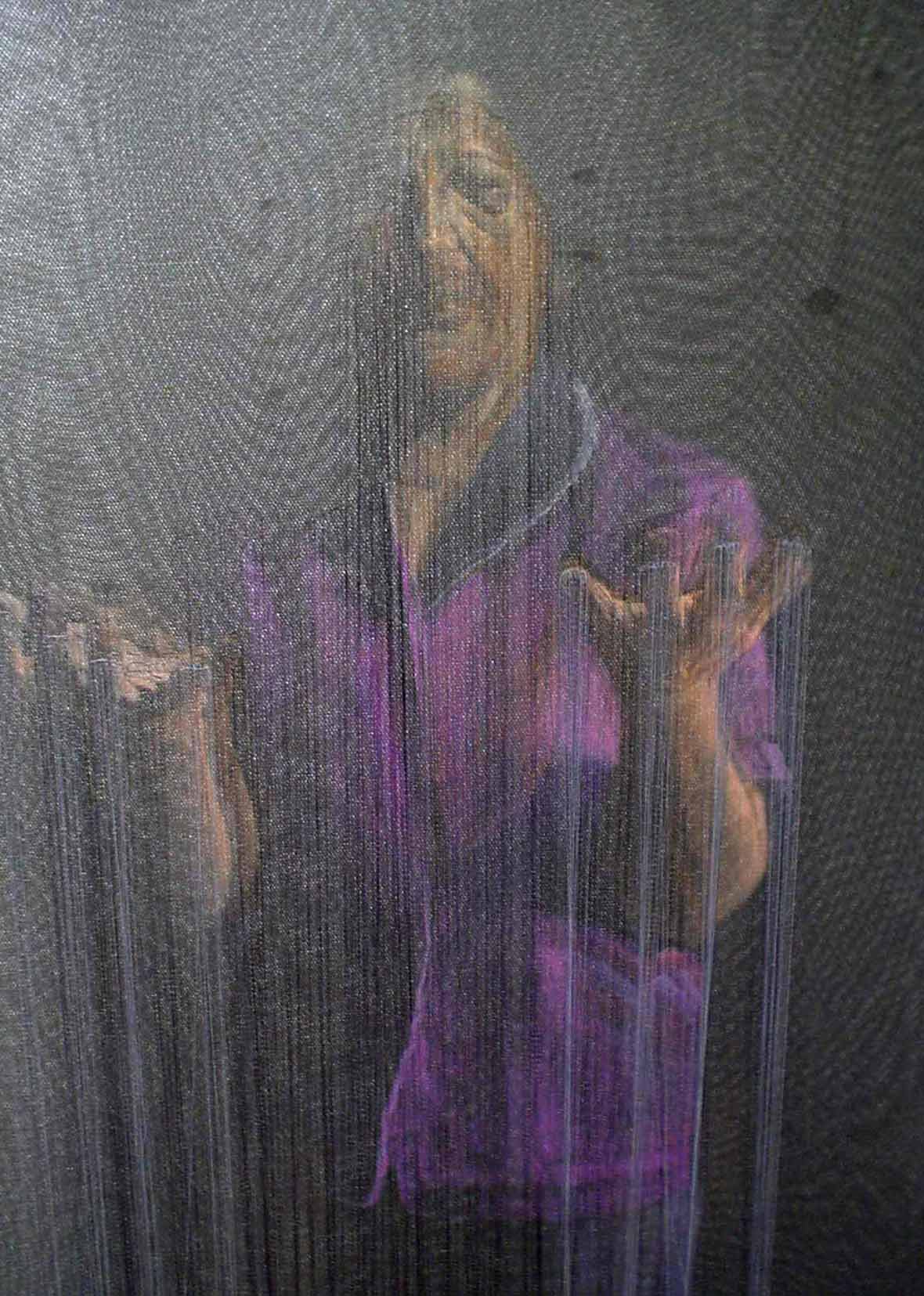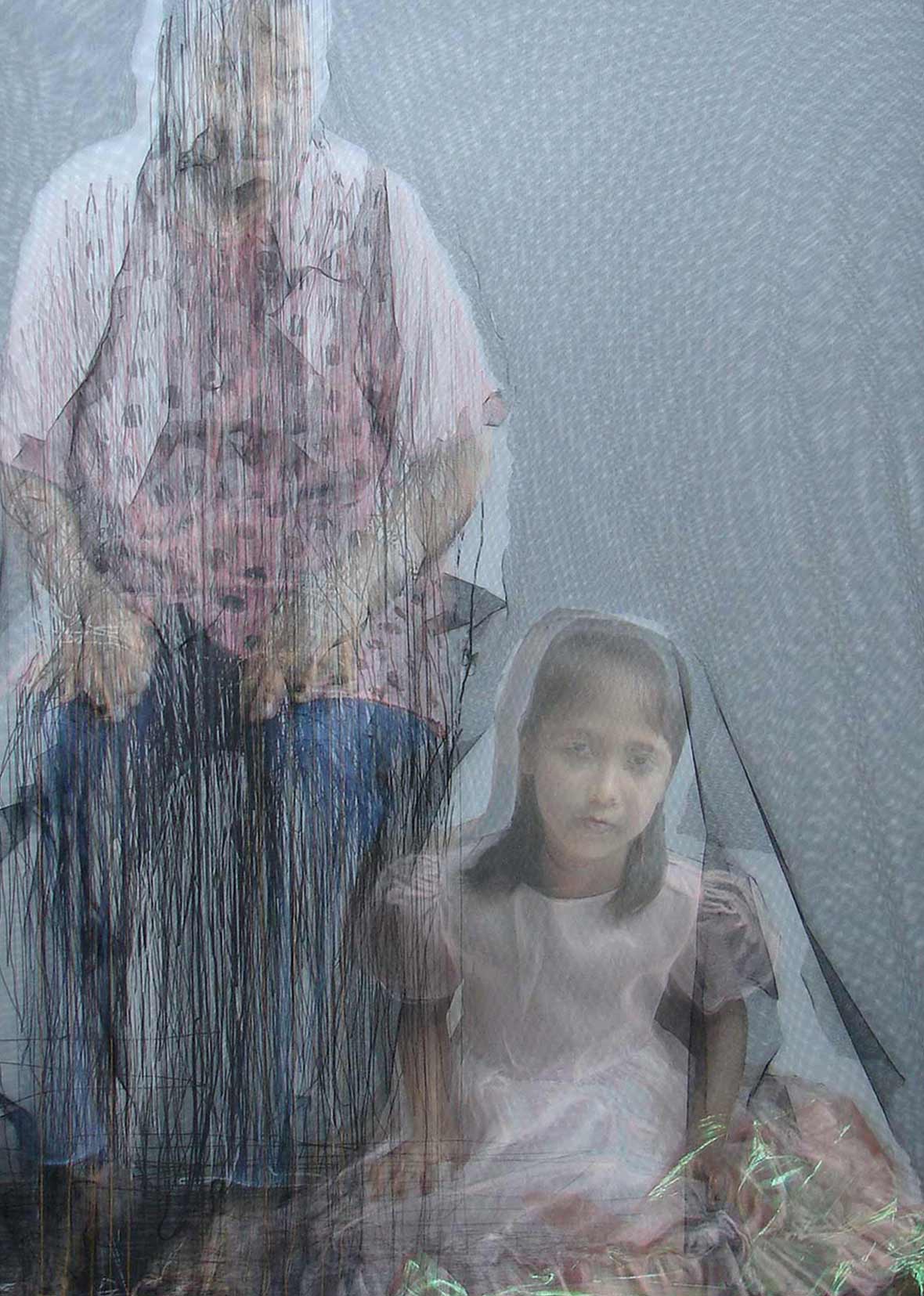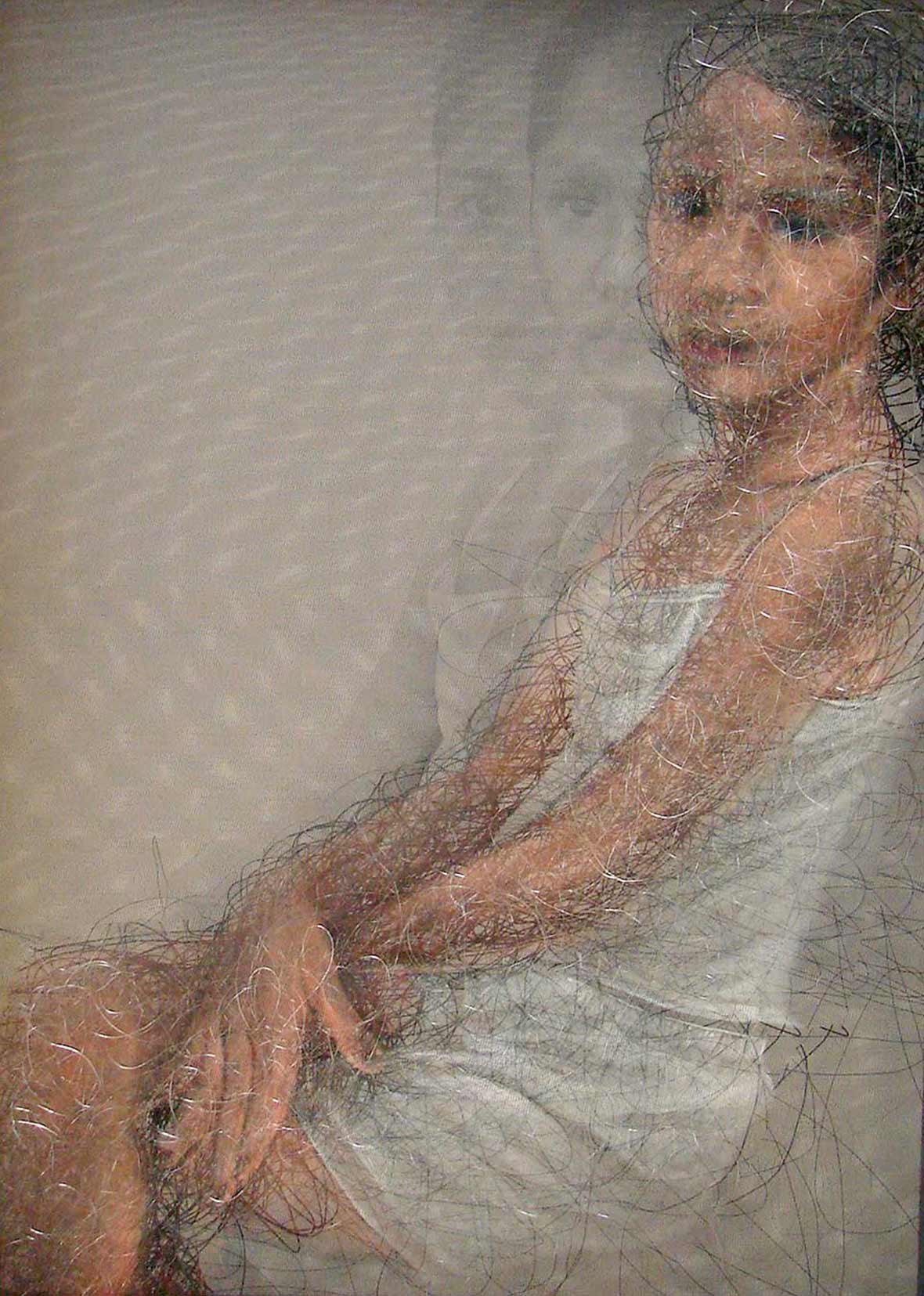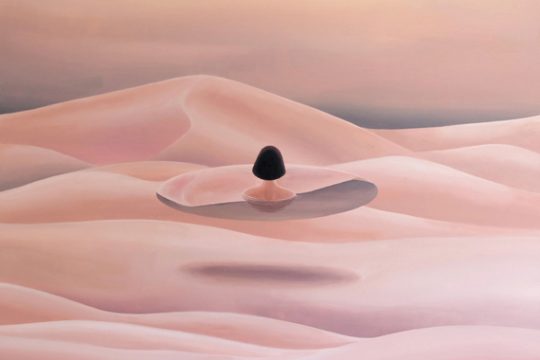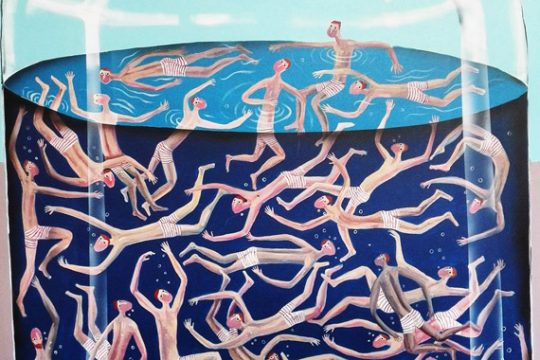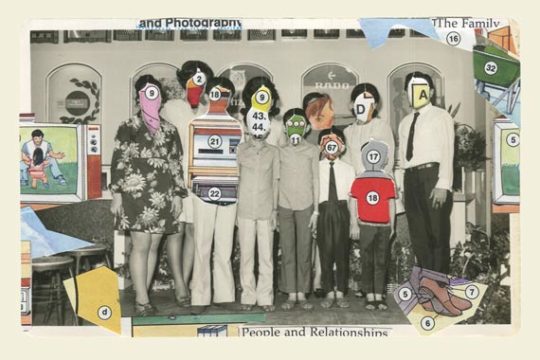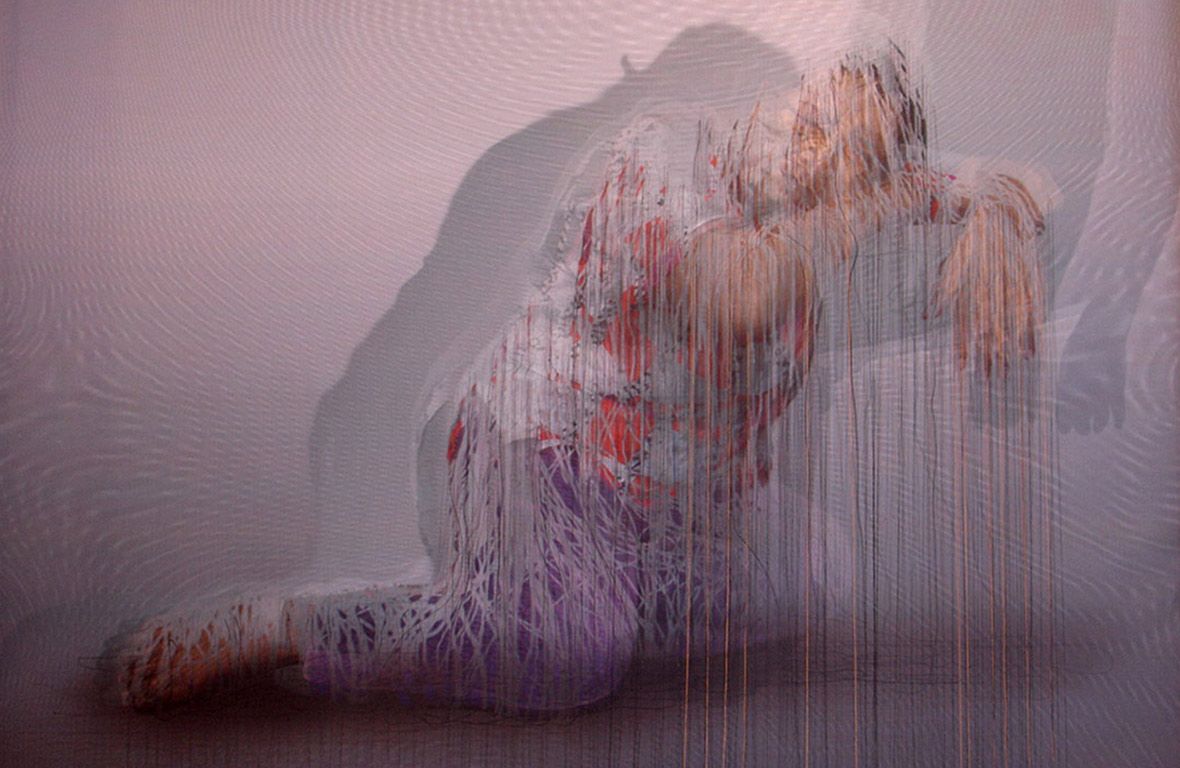
Uttaporn Nimmalaikaew is a Bangkok-based painter who uses netting to create unique works of art. His portraits, suspended on layers and layers of mosquito nets, tulle, and thread, appear three-dimensional in a very analog and tangible way. As a student, he accidentally discovered this technique when paint splashed on a nearby mosquito net. The material gave way to new dimensions of painting. Using this technique, Uttaporn painted mostly portraits of his family members – especially his mother, who is an important source of inspiration for him. Neocha spoke to him recently about his process and the themes behind his work.
อัฐพร นิมมาลัยแก้วเป็นศิลปินจากกรุงเทพมหานครผู้ใช้ตาข่ายในการสร้างงานศิลปะที่เป็นเอกลักษณ์ ภาพใบหน้าของเขาซึ่งแขวนอยู่บนผ้าขาวบางหลายชั้น มุ้งกันยุงและด้ายดูเหมือนเป็นภาพสามมิติซึ่งมีความหมายในเชิงอุปมานเป็นอย่างมากและสัมผัสได้ เมื่อสมัยที่เขาเป็นนักเรียน เขาได้ค้นพบเทคนิคนี้โดยบังเอิญเมื่อมีสีสาดใส่มุ้งกันยุงที่อยู่ใกล้เคียง วัสดุนั้นมอบมุมมองในการสร้างภาพแบบใหม่ให้กับเขา ด้วยการใช้เทคนิคนี้ อัฐพรวาดภาพส่วนใหญ่ของสมาชิกครอบครัวและแม่ของเขาผู้ซึ่งเป็นแรงบันดาลใจหลักของเขา เราได้พูดคุยกับเขาเมื่อเร็ว ๆ นี้ถึงกระบวนการการทำงานของเขาและธีมภายหลังงานของเขา
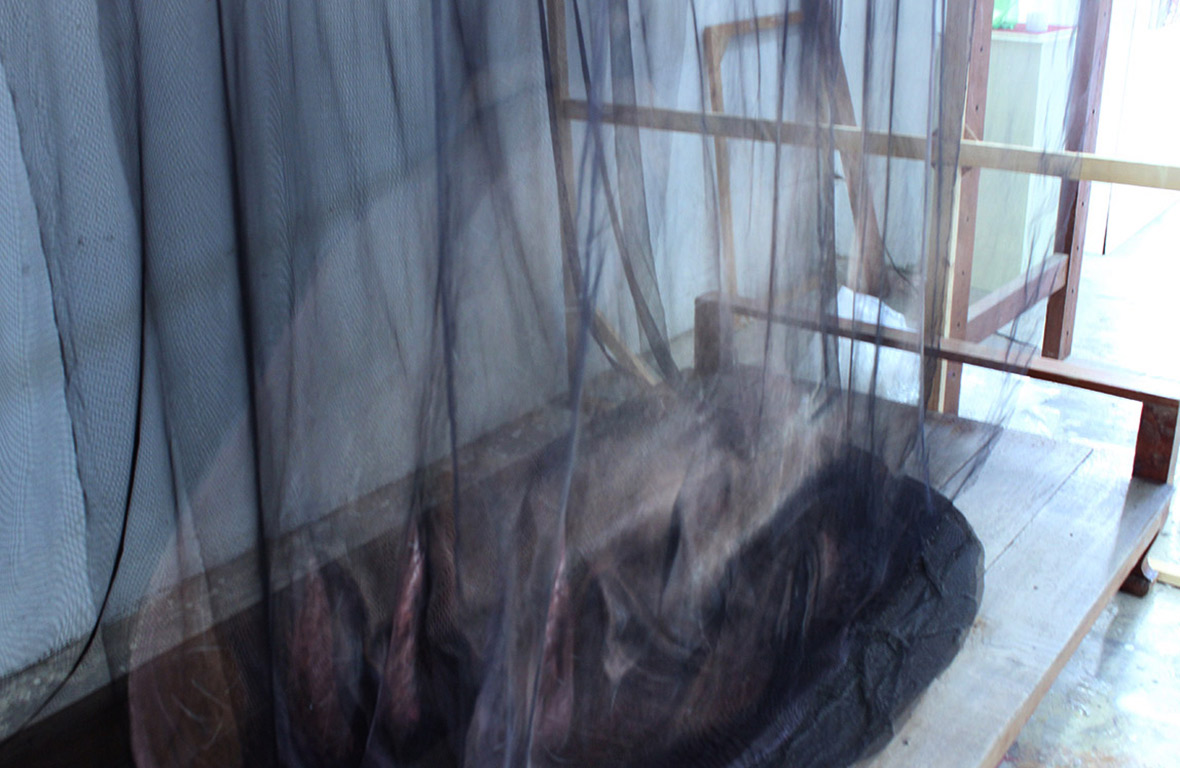
Neocha: How did you first get started as an artist? When did you decide to experiment with mosquito net and tulle? Why did you choose these materials instead of more traditional painting media?
Uttaporn: I started in 2001 when I sent my work to art competitions. I am not only an artist, but also a full-time lecturer at the university. At the time, I was painting, but I thought that just painting on canvas wasn’t enough. I needed a way to make it unique. I tried many new techniques, and experimented with using different materials until I discovered painting on tulle by accident. I was sleeping in the mosquito net at my studio and I noticed a spot of paint on it. I saw the special properties of the material. Mosquito net is sparse: it wavers, it’s movable, and the layers can create the illusion of popping out. Nobody used this technique at the time. I found painting on tulle can represent emotions and senses very well because of the materials’ own properties. It is transparent and dimensional, which results in a mystical and attractive look. I’ve been developing both this technique and the concepts behind my work ever since then.
Neocha: คุณเริ่มเป็นศิลปินได้อย่างไร? คุณตัดสินใจเริ่มทดลองใช้มุ้งกันยุงและผ้าขาวบางเมื่อใด? ทำไมคุณถึงเลือกใช้วัสดุเหล่านี้แทนวัสดุการวาดภาพแบบดั้งเดิม?
Uttaporn: ผมเริ่มในปี 2001 ตอนที่ผมส่งงานของผมไปร่วมการแข่งขันศิลปะ ผมไม่ได้เป็นเพียงศิลปินแต่ยังเป็นอาจารย์ประจำในมหาวิทยาลัยอีกด้วย ในขณะนั้นผมได้วาดรูปแล้วแต่คิดว่าการวาดรูปบนผืนผ้าใบนั้นยังไม่เพียงพอ; ผมต้องการวิธีที่จะทำให้มันเป็นเอกลักษณ์ ผมทดลองเทคนิคอันหลากหลายโดยใช้วัสดุต่าง ๆ มากมายจนกระทั่งผมค้นพบการวาดภาพบนผ้าขาวบางโดยบังเอิญ ผมกำลังหลับอยู่ในสตูดิโอของผมและผมสังเกตเห็นจุดสีบนนั้น ผมเห็นลักษณะพิเศษของวัสดุ เส้นของมุ้งกันยุงแต่ละเส้นนั้นห่างกัน มันพลิ้วไหว มันเคลื่อนไหวได้ และเมื่อซ้อนกันเป็นชั้น มันสามารถสร้างภาพลวงตาว่ามันนูนขึ้นมาได้ในขณะนั้นไม่มีใครใช้เทคนิคนี้ การวาดภาพบนผ้าขาวบางสื่อถึงอารมณ์และความรู้สึกได้เป็นอย่างดีเนื่องด้วยลักษณะของวัสดุ มันโปร่งแสงและมีมิติ ซึ่งสร้างรูปแบบที่ลึกลับและน่าสนใจได้ หลังจากนั้นผมก็ได้พัฒนาทั้งเทคนิคและแนวคิดภายหลังงานของผม
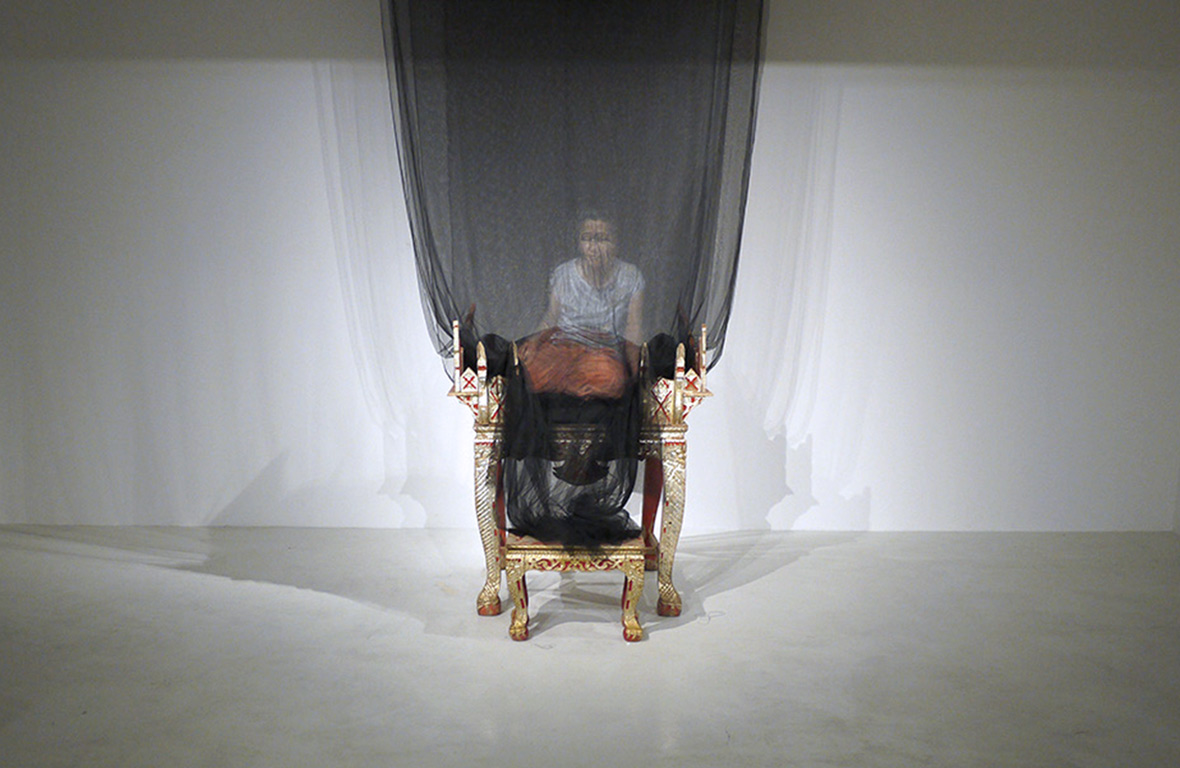
Neocha: Can you tell us about your work process? How do you work from initial concept to the finished piece of art? Since your work is so layered and multi-dimensional, how do you envision the final creation beforehand? Do you use photography, sketching, modeling, or any other methods?
Uttaporn: My work processes differs depending on the project and artworks themselves. Sometimes, I print out the base layer, and on top, I paint to create the first layer. Sometimes, I only paint on the fabric for all the layers, and put them together until they create a 3D illusion. Sometimes I don’t paint, but instead use scissors or a soldering pen to cut on the fabric in order to have more diverse pieces of work.
Generally, I do plan my work and how I will paint it by sketching first. I will check the sizes and dimensions of the objects that should be on each layer. On the first layer, I paint the subject clearly and complete the configuration of the overall shape. On the next layers, I only paint the particular areas that I want to focus on and pop out. On the last layer, I paint the details of the subject such as the nose, mouth, fingers and feet.
Neocha: ช่วยบอกเราถึงขั้นตอนการทำงานของคุณได้หรือไม่ – คุณเริ่มจากแนวคิดไปจนถึงการทำผลงานให้เสร็จสิ้นอย่างไรบ้าง? เนื่องจากผลงานของคุณมีหลายชั้นและหลายมิติมาก คุณจินตนาการถึงผลงานเมื่อเสร็จสิ้นได้อย่างไร? คุณใช้การถ่ายภาพ การร่างภาพ การสร้างโมเดลหรือวิธีการอื่น ๆ หรือไม่?
Uttaporn: ผลงานของผมแตกต่างกันไปตามโปรเจกต์และผลงานศิลปะนั้น ๆ บางครั้งผมก็พิมพ์เลเยอร์พื้นฐานออกมาก่อน แล้วก็วาดลงไปบนนั้นเพื่อสร้างชั้นแรก บางครั้งผมก็วาดบนผ้าอย่างเดียวเพื่อสร้างทุกชั้นขึ้นมา แล้ววางมันซ้อนกันให้เกิดภาพลวงตาแบบ 3D บางครั้งผมก็ไม่ได้วาดเลย แต่จะใช้กรรไกรหรือปากกาบัดกรีในการตัดผ้าออกมาเพื่อให้ผลงานศิลปะนั้นดูมีเทคนิคที่หลากหลายยิ่งขึ้น
โดยรวมแล้ว ผมมีการวางแผนการทำงานและวิธีการวาดมันก่อนด้วยการร่าย ผมจะตรวจสอบขนาดและมิติของวัตถุที่ต้องอยู่บนแต่ละชั้น ในชั้นแรก ผมจะวาดวัตถุนั้นให้ชัดเจนและทำให้ส่วนต่าง ๆ ของรูปทรงรวมนั้นสมบูรณ์ ในชั้นถัดไป ผมจะวาดเฉพาะพื้นที่เฉพาะที่ผมต้องการใส่ใจและอยากให้มันโดดเด่น ในชั้นสุดท้าย ผมจะวาดรายละเอียดของตัวบุคคลนั้น ๆ เช่น จมูก ปาก นิ้วและเท้า
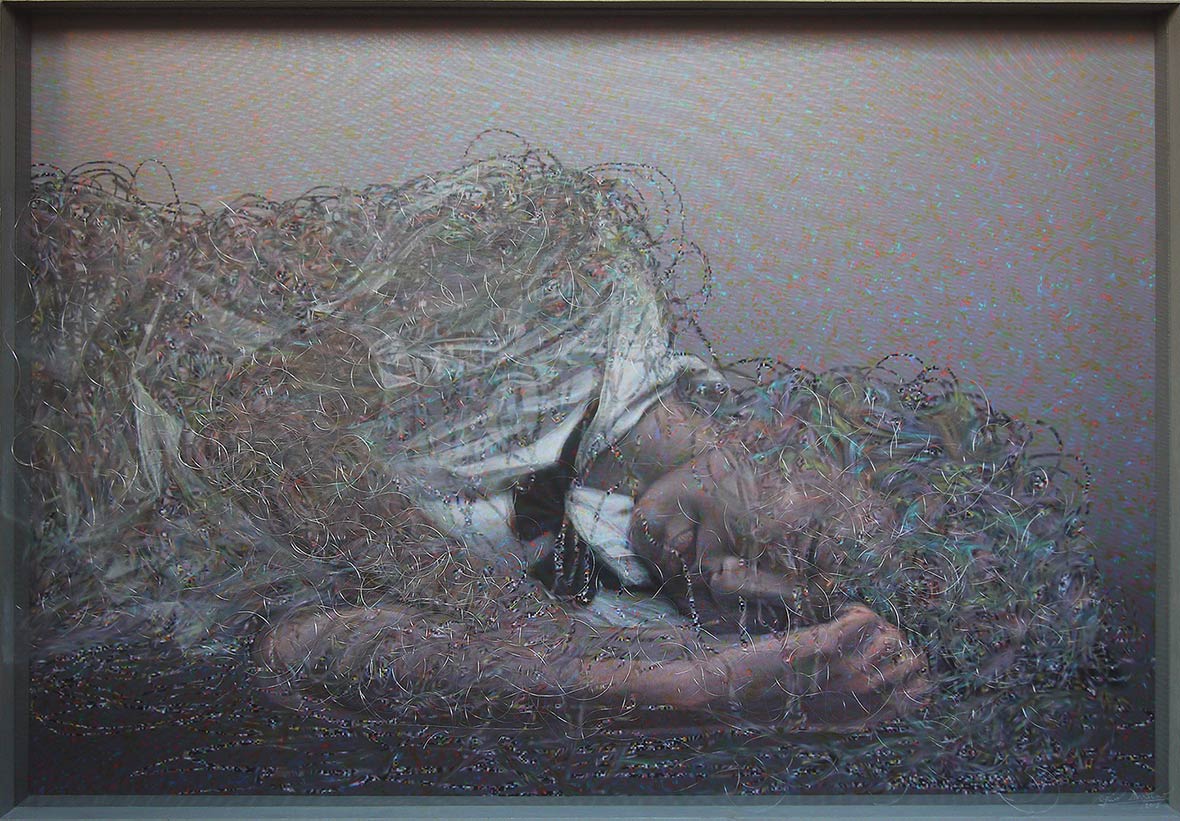
Neocha: Through your unique work process, what is the biggest challenge? What piece was the most difficult to conceive of?
Uttaporn: The most difficult part is measuring the distance between the layers which need to be placed correctly to create the 3D illusion for the viewer. This takes some time for me to plan out. The pieces which challenge me the most are the ones which incorporate objects, such as a chair or a bed. I also have to plan how to have them match up and incorporated into the illusion. For many pieces of my artworks, I do a lot of trials beforehand. I would say my artwork is a mixture of painting and sculpture.
Neocha: ในขั้นตอนการทำงานอันพิเศษของคุณนี้ มีอะไรเป็นความท้าทายที่ยิ่งใหญ่ที่สุด? ผลงานชิ้นใดเป็นชิ้นที่ผลิตออกมายากที่สุด?
Uttaporn: ส่วนที่ยากที่สุดคือการวัดระยะทางระหว่างแต่ละเลเยอร์ ซึ่งมันต้องได้รับการวาดให้ถูกต้องเพื่อที่ผู้ชมจะได้เกิดภาพลวงตาแบบ 3D ผมต้องใช้เวลาสักเล็กน้อยในการทำความเข้าใจจุดนี้ ผลงานที่ท้าทายตัวผมมากที่สุดคือผลงานซึ่งประกอบไปด้วยวัตถุต่าง ๆ เช่นเก้าอี้หรือเตียง ผมยังต้องวางแผนให้กับมันเป็นอย่างมาก เพื่อให้มันเข้ากันได้ดีและประกอบกันเป็นภาพลวงตา สำหรับผลงานส่วนใหญ่ ผมจะทดลองเป็นจำนวนหลายครั้ง มันเป็นส่วนผสมระหว่างการวาดและประติมากรรม เพื่อก่อให้เกิดผลงานศิลปะขึ้นมา
Neocha: Birth, life, and death are prominent themes in your work. What attracts you to these themes and who are the characters you portray?
Uttaporn: I am personally interested in the truth of life, which is referred from Buddha’s teaching, but I represent his teaching in my own way. I use my own experiences and feelings to interpret his teachings, but I’m open for others to interpret my work in their own way as well. My art is inspired by seeing my family members, such as my father, mother, sister and other beloved ones – and how they are changing in bodies and in minds. My parents are getting older and older. My sister who fights to live, which makes me aware, concerned, worried and even scared of that change. These feelings motivate me to create the artworks using this tulle technique. This truth, called dhukka, is something that happens to everybody. After seeing my work, I hope people will consider it more, and even begin to accept it.
Neocha: ช่วยบอกเราถึงขั้นตอนการทำงานของคุณได้หรือไม่ – คุณเริ่มจากแนวคิดไปจนถึงการทำผลงานให้เสร็จสิ้นอย่างไรบ้าง? เนื่องจากผลงานของคุณมีหลายชั้นและหลายมิติมาก คุณจินตนาการถึงผลงานเมื่อเสร็จสิ้นได้อย่างไร? คุณใช้การถ่ายภาพ การร่างภาพ การสร้างโมเดลหรือวิธีการอื่น ๆ หรือไม่?
Uttaporn: ผลงานของผมแตกต่างกันไปตามโปรเจกต์และผลงานศิลปะนั้น ๆ บางครั้งผมก็พิมพ์เลเยอร์พื้นฐานออกมาก่อน แล้วก็วาดลงไปบนนั้นเพื่อสร้างชั้นแรก บางครั้งผมก็วาดบนผ้าอย่างเดียวเพื่อสร้างทุกชั้นขึ้นมา แล้ววางมันซ้อนกันให้เกิดภาพลวงตาแบบ 3D บางครั้งผมก็ไม่ได้วาดเลย แต่จะใช้กรรไกรหรือปากกาบัดกรีในการตัดผ้าออกมาเพื่อให้ผลงานศิลปะนั้นดูมีเทคนิคที่หลากหลายยิ่งขึ้น
โดยรวมแล้ว ผมมีการวางแผนการทำงานและวิธีการวาดมันก่อนด้วยการร่าย ผมจะตรวจสอบขนาดและมิติของวัตถุที่ต้องอยู่บนแต่ละชั้น ในชั้นแรก ผมจะวาดวัตถุนั้นให้ชัดเจนและทำให้ส่วนต่าง ๆ ของรูปทรงรวมนั้นสมบูรณ์ ในชั้นถัดไป ผมจะวาดเฉพาะพื้นที่เฉพาะที่ผมต้องการใส่ใจและอยากให้มันโดดเด่น ในชั้นสุดท้าย ผมจะวาดรายละเอียดของตัวบุคคลนั้น ๆ เช่น จมูก ปาก นิ้วและเท้า

